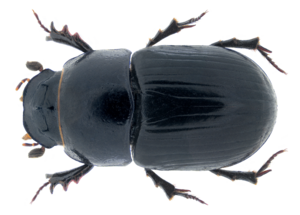Teuchestes fossor facts for kids
Quick facts for kids Teuchestes fossor |
|
|---|---|
 |
|
| Teuchestes fossor, Italy | |
| Conservation status | |
|
Invalid status (NatureServe)
|
|
| Scientific classification | |
| Genus: |
Teuchestes
|
| Species: |
fossor
|
| Synonyms | |
|
|
The Teuchestes fossor is a type of dung beetle. It is originally from a large area called the Palaearctic, which includes Europe and Asia. This beetle is also found widely in North America. It arrived there by accident when Europeans first settled the continent.
Both adult beetles and their young (larvae) eat animal dung. They are special because adults eat the liquid parts, while larvae eat the tougher, fibrous parts. You can often find these beetles in the dung of farm animals and other large mammals. Teuchestes fossor helps with many important jobs in cattle pastures.
This beetle used to be known by a different name, Aphodius fossor.
Contents
What it Looks Like
Adult Beetles
The Teuchestes fossor is a shiny black beetle. It is shaped like a dome, or very rounded on top. It measures about 8 to 12 millimeters (about 0.3 to 0.5 inches) long. It is also about 2 to 3 millimeters (about 0.08 to 0.12 inches) wide.
Its back shield, called the scutellum, is long. The lines on its wing covers (elytra) are quite thin. The front part of its body, called the pronotum, has many small dents near the sides and front. Most of these beetles are glossy black. Sometimes, though, you might find a rare dark red one. Male beetles have a small horn on their head, which helps tell them apart from females.
Larvae (Young Beetles)
The larvae of Teuchestes fossor look like typical C-shaped grubs. These are the young forms of scarab beetles. They grow through three stages, called instars, before they turn into pupae.
How it Lives
Like other beetles in its group, Teuchestes fossor is an 'endocoprid' beetle. This means it lives and eats inside the dung, instead of rolling it into balls. Adult beetles prefer to live in older cattle dung. They might move between different piles of dung as they get older.
Female beetles lay their eggs one by one. They place them under the crust of the dung or in the soil right below it. Adult beetles usually live in pairs and are not found in large groups. They likely use special scents called pheromones to find mates and avoid too many beetles in one spot. Even though they live in open areas like pastures, these beetles don't do well in very dry conditions. Their larvae can die if they are too exposed to dry weather.
How it Helps Nature
Both the larvae and adult Teuchestes fossor beetles help dung disappear faster from pastures. When the dung is removed, new grass can grow. This also helps put important nutrients back into the soil. It can also help make the soil less compacted. Since adults and larvae often feed where the soil and dung meet, they might accidentally pull soil into the dung. This means they might help remove even more dung than we realize!
See also
 In Spanish: Aphodius fossor para niños
In Spanish: Aphodius fossor para niños

